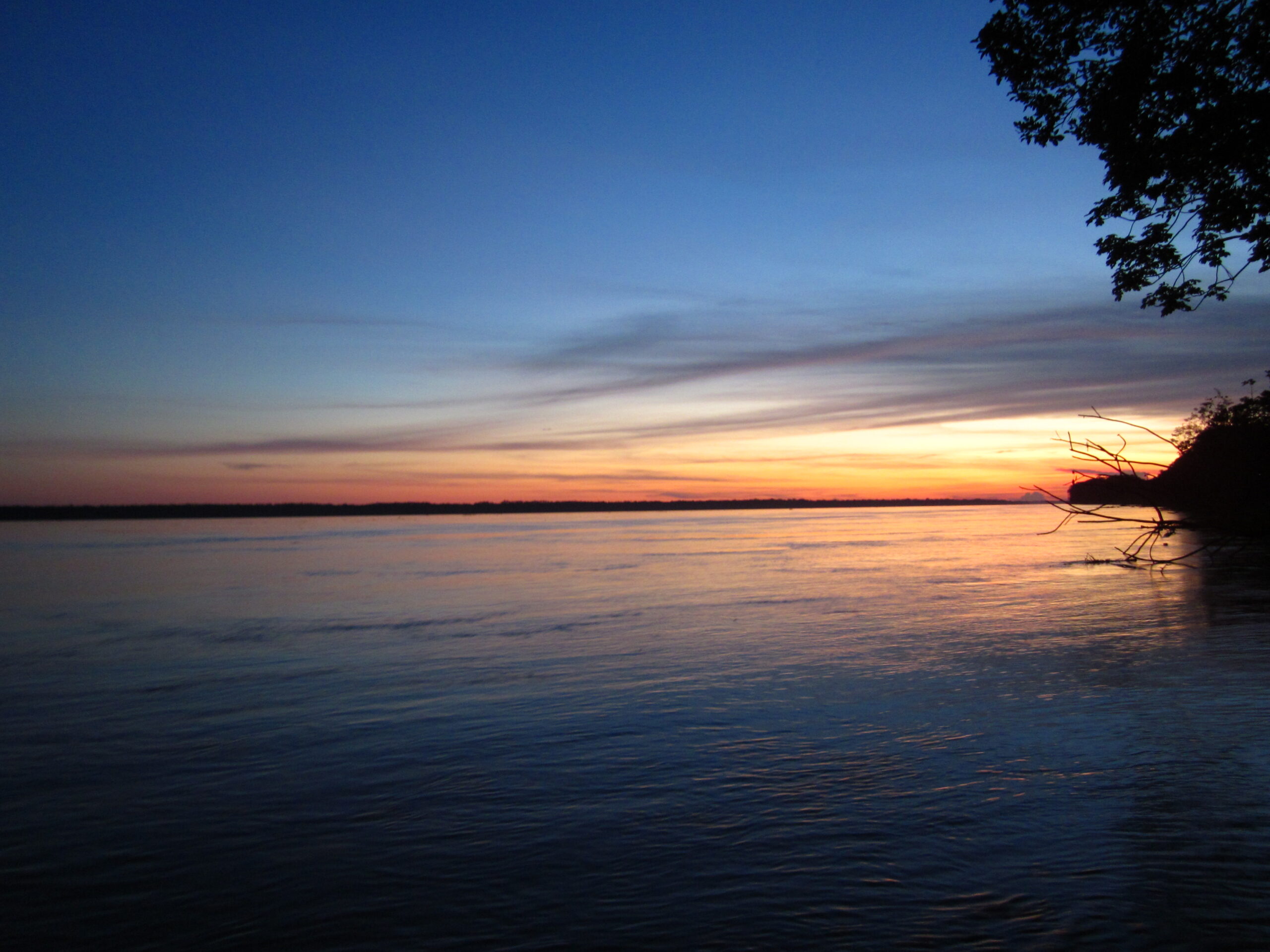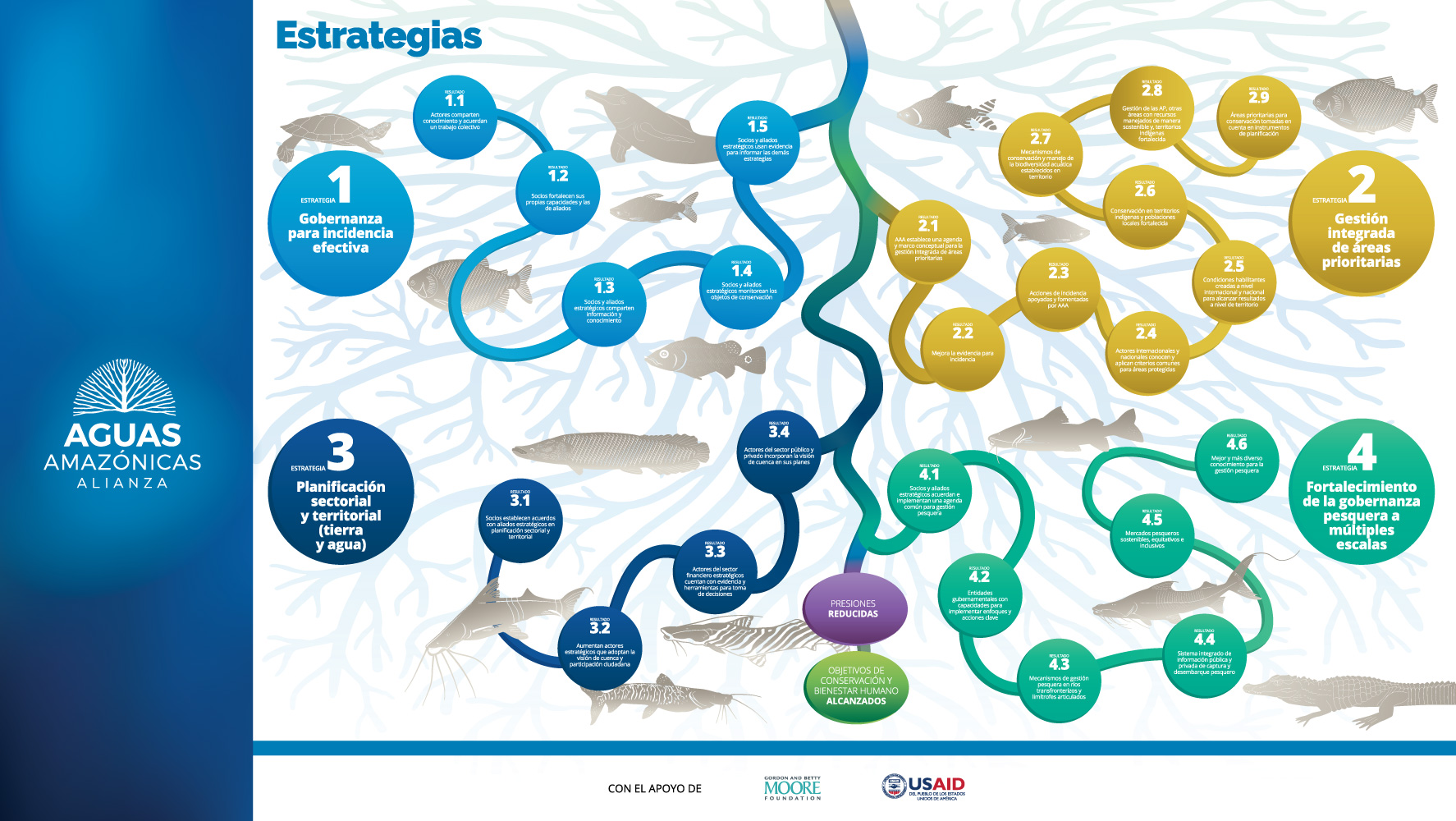THE STRATEGY
The Amazon Basin is a region that must be valued not just for its rich tropical forests and its importance for carbon storage, but for its role as the world’s greatest and most diverse freshwater system.
We will have achieved this vision when:
- Wetlands critical to wildlife, human livelihoods, and ecosystem function are conserved;
- Fisheries, especially those for migratory fish that cross various jurisdictions, are well-managed;
- The environmental impacts of infrastructure projects and extractive industries like oil, gas, and mining are minimized.

Importance of the Amazon Basin
The importance of the Amazon Basin
A Amazon Basin is the largest tropical wilderness in the world, the most biologically diverse place on Earth, and home to hundreds of indigenous peoples and other traditional cultures. It is also the largest freshwater system in the world, accounting for 15% of the freshwater discharge into global oceans — six times larger than the second most important system (which is the Congo River). The Amazon has more than 2,400 species of fish, more than found in any other river basin, and some of these fish make the longest freshwater fish migrations in the world (4000+km, one way).
Yet when many people think of the Amazon, they envision only the great rainforest threatened by colonization, roads, cattle ranches, and plantations, whose loss and degradation has global consequences. Rarely do non-Amazonian people visualize this immense system from the perspective of water flowing through it. Once thought to cover a mere 4% of the Amazon, our science now shows that flooded forests, rivers, lakes and other wetlands cover a vast 14% of the basin. These aquatic ecosystems are an integral part of life in Amazonia, critical not only to biodiversity but also for sustaining major fisheries, supplying domestic water, providing a vast transportation network and other aquatic resources for 30 million Amazonian residents, including 1.4 million indigenous people.
Conservation efforts today in the Amazon Basin largely focus on creating and strengthening management of protected areas and indigenous territories. A half century of such efforts have been vital to secure forested landscapes and provide tenure and access to resources for traditional peoples, but they have done little to protect the Basin’s aquatic systems, provide for the long term sustainability of their natural resources, or ensure Basin-wide connectivity. To address these challenges, conservation and management efforts must now focus on waters, wetlands and basins and important resources such as fisheries, and should be based on integrated river basin management.
Threats
Threats
The integrity of the Amazon’s highly productive and immensely valuable wetland ecosystems is challenged for three primary reasons, and the pace and scale of these threats require urgent action now to respond while there is still time.
Unmanaged fisheries. The highly productive fisheries of the Basin are not managed at the appropriate scale. 80% of fish landings are migratory species whose life history takes them between various sub-basins and countries and, in some cases, from the Amazon River estuary to Andean headwaters more than 4,000 km upstream. Yet no fisheries management system operates at a basin-wide scale, and unsustainable commercial and subsistence fishing is the norm, threatening one of the most important protein sources in the Amazon.
Infrastructure. Existing or planned infrastructure development impacts are poorly understood, including those from hydroelectric dams, roads, waterways, mining and oil and gas extraction, and if left unmitigated risk water quality and quantity, nutrient and sediment cycles, and even the normal annual flooding regime over vast areas, with unpredictable consequences. These flows are essential to the productivity of wetland forests and the fish and other animals that feed in them during high water periods. They are also essential to wild fruit production, floodplain agriculture, river transport and human settlements.
Climate Change. Climate change is already and will continue to affect the Amazon’s seasonal flood cycle. Climate change models indicate that these disruptions will lead to large-scale changes in wetlands – including flooded forests – and their biodiversity, including fish species on which fisheries and ultimately food security depend. These changes will augment the well-known risks of deforestation and land cover change. Together with infrastructure, these impacts are likely to exacerbate more extreme and less predictable flood pulses. Hundreds of thousands rural people actually live in or directly adjacent to wetland areas that would be directly affected by these major hydrological changes, in addition to the millions of urban residents whose livelihoods depend less directly on the great river system.
Strategy
Years of research and analysis by a multinational, multidisciplinary, and multi-institutional team of scientists and practitioners has yielded a new scientific understanding of the Amazon based in an unprecedented basin-wide analysis of freshwater ecosystems. The Amazon Waters Alliance has thus provided us with a strong scientific foundation, and we are now in a position to suggest management and policy pathways for large-scale conservation of the great river system. Our aim is to build a broad coalition of Amazonian and International partners in support of this agenda.
The Strategy
For the identification of strategies, a reflection focused on the scale of the Amazon Basin was encouraged, foreseeing the combination of different types of strategies, and capitalizing on lessons learned in the Citizen Science Network for the Amazon and by its partners and other key actors in relation to “scaling up” strategies. As this is a regional plan, some strategies operate as an umbrella, indicating the general direction of actions and results to be achieved at more local scales.
Strategy one: Governance for effective advocacy
Strengthen governance, partner participation and functioning of the Amazon Waters Alliance to achieve effective advocacy using scientific information as a key element. It corresponds to a support strategy that seeks to achieve effective inter-institutional collaboration and facilitate the implementation of advocacy strategies.
The advocacy strategies are:
Strategy two: Integrated management of priority areas
Establish and strengthen the integrated management of priority areas for the conservation and management of aquatic biodiversity and its linkage with the forest (protected areas, conserved areas -OMEC-, indigenous territories and other areas with sustainably managed resources).
Strategy three:
Influence sectoral and territorial planning (land and water) to optimize development investments in major rivers, maximizing benefits and ensuring an equitable distribution of benefits, and minimizing their negative impacts.
Strategy four: Strengthen fisheries governance at multiple scales
Strengthen fisheries governance, collaboratively, at multiple scales with an ecosystem approach adapted to the Amazon Basin.
Together, the advocacy strategies seek to improve the planning, implementation and management of large-scale infrastructure at the basin level, contribute to reducing priority threats and achieve conservation and human well-being objectives. To this end, they seek to achieve a series of outcomes described in the theory of change.
Download here the infographic about the Amazon Waters Alliance Strategy (in Spanish).


